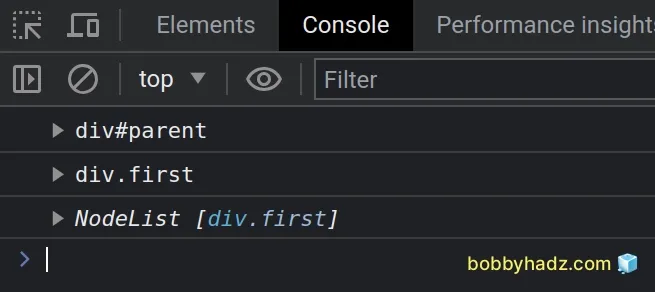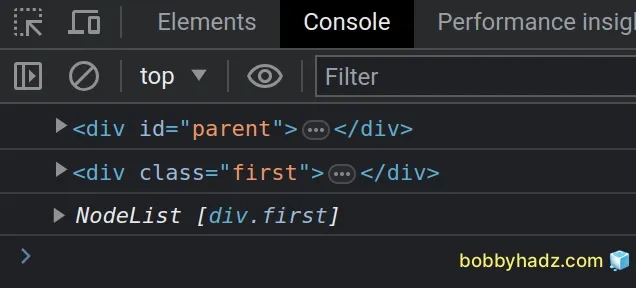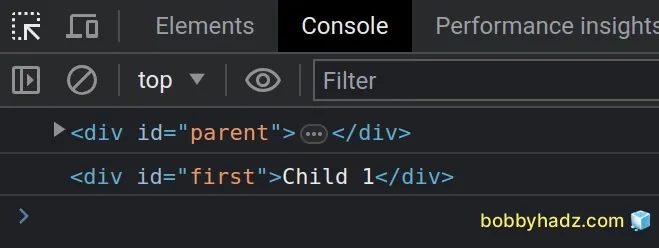Get Child Element by ID, Class or Tag in JavaScript
Last updated: Mar 4, 2024
Reading time·6 min

# Table of Contents
- Get Child Element by Class using JavaScript
- Get Child Element by ID using JavaScript
- Get Child Elements by Tag name using JavaScript
# Get Child Element by Class using JavaScript
To get a child element by class:
- Use the
document.querySelector()method to get the parent element. - Call the
querySelectormethod on the parent element passing it the class name as a parameter. - For example,
parent.querySelector('.first')gets the child with classfirst.
Here is the HTML for the examples in the article.
<!DOCTYPE html> <html lang="en"> <head> <meta charset="UTF-8" /> <title>bobbyhadz.com</title> </head> <body> <div id="parent"> <div class="first">Child 1</div> <div class="second">Child 2</div> </div> <script src="index.js"></script> </body> </html>
And here is the related JavaScript code.
const parent = document.querySelector('#parent'); console.log(parent); // 👉️ div#parent const child1 = parent.querySelector('.first'); console.log(child1); // div.first const children = parent.querySelectorAll('.first'); console.log(children); // 👉️ [div.first]

If you need to get a Child element by Tag or ID, click on the corresponding subheading:
We used the
document.querySelector()
method to get the parent element by its id.
In this scenario, we could have used the document.getElementById() method to
achieve the same result.
const parent = document.getElementById('parent');
The next step is to call the querySelector() method on the parent element.
querySelector method is scoped to a specific element, it only selects the children of the element the method was called on.The Element.querySelector() method returns the first child element that
matches the provided selector.
If you need a collection of the children that have the specific class, use the Element.querySelectorAll() method.
const parent = document.querySelector('#parent'); console.log(parent); // 👉️ div#parent const children = parent.querySelectorAll('.first'); console.log(children); // 👉️ [div.first]
querySelector and querySelectorAll methods, we are selecting all of the children of the element.This includes nested children that have the supplied class.
# Only get the Direct children of a DOM element
If you only want to target direct children of the DOM element, use the :scope
pseudo-class selector.
Here is the HTML for the example.
<!DOCTYPE html> <html lang="en"> <head> <meta charset="UTF-8" /> </head> <body> <div id="parent"> <div class="first"> Child 1 <!-- 👇️ Nested element with same class --> <div class="first">Nested Child 1</div> </div> <div class="second"> Child 2 </div> </div> <script src="index.js"></script> </body> </html>
And here is the related JavaScript code.
const parent = document.querySelector('#parent'); console.log(parent); // 👉️ div#parent // ✅ get the first direct child with specific class const child1 = parent.querySelector(':scope > .first'); console.log(child1); // div.first // ✅ get all direct children with specific class const children = parent.querySelectorAll(':scope > .first'); console.log(children); // 👉️ [div.first]

We used the :scope pseudo-class to select the
direct children
of the DOM element that has a class of first.
When used with methods like querySelector and querySelectorAll, :scope
matches the element on which the method was called (the parent).
You can use the querySelectorAll method to get all direct child elements with
the specified class or the querySelector method to get only the first child
element with the given class.
If you don't need access to the parent element, you can turn this into a one step process.
const children = document.querySelectorAll('#parent > .first'); console.log(children); // 👉️ [div.first] const child = document.querySelector('#parent > .first'); console.log(child); // 👉️ div#first
This selector works in the same way as using :scope, but doesn't require us to call the document.querySelectorAll() method scoped to a particular element.
querySelector or querySelectorAll methods, :scope matches the element on which the method was called (the parent).The example shows how to get all div elements that are direct children of an
element with an id set to parent.
# Get Child Element by ID using JavaScript
To get a child element by id:
- Use the
document.querySelector()method to get the parent element. - Call the
querySelectormethod on the parent element passing it the id as a parameter. - For example,
parent.querySelector('#first')gets the child with idfirst.
Here is the HTML for the examples in the article.
<!DOCTYPE html> <html lang="en"> <head> <meta charset="UTF-8" /> <title>bobbyhadz.com</title> </head> <body> <div id="parent"> <div id="first">Child 1</div> <div>Child 2</div> </div> <script src="index.js"></script> </body> </html>
And here is the related JavaScript code.
const parent = document.querySelector('#parent'); console.log(parent); // 👉️ div#parent const child = parent.querySelector('#first'); console.log(child); // div#first

We used the
document.querySelector()
method to get the parent element by its id.
In this scenario, we could have used the document.getElementById method to
achieve the same result, e.g.:
const parent = document.getElementById('parent');
querySelector method we prefix the id with a hash # and when using getElementById - we don't.The next step is to call the querySelector method on the parent element.
querySelector method is scoped to a specific element, it only selects the children of the element the method was called on.The Element.querySelector() method returns the first element that matches the
provided selector.
In the example, we select a child element that has an id value set to first.
const parent = document.querySelector('#parent'); console.log(parent); // 👉️ div#parent const child = parent.querySelector('#first'); console.log(child); // div#first
id to the querySelector method, we are selecting any of the children of the element.This includes nested children that have the supplied id.
However, it shouldn't matter because the IDs on your page should be unique.
Having multiple elements with the same id on a single page can lead to
confusing behavior and difficult-to-track bugs.
# Get Child Elements by Tag name using JavaScript
Use the querySelectorAll method to get all child elements by tag name.
For example, document.querySelectorAll('#parent div') selects all of the
div elements that are descendants of an element with an id of parent.
Here is the HTML for the examples.
<!DOCTYPE html> <html lang="en"> <head> <meta charset="UTF-8" /> <title>bobbyhadz.com</title> </head> <body> <div id="parent"> <div>Child 1</div> <div>Child 2</div> <span>Child 3</span> </div> <script src="index.js"></script> </body> </html>
And here is the related JavaScript code.
const children = document.querySelectorAll('#parent div'); console.log(children); // 👉️ [div, div]
If you need to access elements of multiple types, separate them by a comma.
const children = document.querySelectorAll('#parent div, span'); console.log(children); // 👉️ [div, div, span]
We used the document.querySelectorAll()
method to select all div elements that are children of an element with an id
of parent.
You could also achieve the same result in two simple steps.
const parent = document.querySelector('#parent'); console.log(parent); // 👉️ div#parent const children = parent.querySelectorAll('div'); console.log(children); // 👉️ [div, div]
The call to the document.querySelector() method selected the parent element by
its id.
In this scenario, you could have used the document.getElementById method to
achieve the same result, e.g.:
const parent = document.getElementById('parent');
The next step is to call the querySelectorAll method on the parent element.
querySelectorAll method is scoped to a specific element, it only selects the children of the element the method was called on.The querySelectorAll method returns a NodeList containing the elements that
match the provided selector.
querySelectorAll method, we select any of the children of the element.This includes nested children that are div elements.
# Target direct children of the element
If you only want to target direct children of the DOM element, use the :scope
pseudo-class selector.
Here is the HTML for the example.
<!DOCTYPE html> <html lang="en"> <head> <meta charset="UTF-8" /> <title>bobbyhadz.com</title> </head> <body> <div id="parent"> <div> Child 1 <div>Nested Child 1</div> </div> <div>Child 2</div> <span>Child 3</span> </div> <script src="index.js"></script> </body> </html>
And here is the related JavaScript code.
const parent = document.querySelector('#parent'); console.log(parent); // 👉️ div#parent const children = parent.querySelectorAll(':scope > div'); console.log(children); // 👉️ [div, div]
We used the :scope pseudo-class to select the
direct children
of the parent that are div elements.
div, it wasn't selected.When used with methods like querySelector and querySelectorAll, :scope
matches the element on which the method was called (the parent).
You could also achieve this in a single step:
const children = document.querySelectorAll('#parent > div'); console.log(children); // 👉️ [div, div]
If you don't need access to the parent element, you can use a single call of the
querySelectorAll method to get the direct children of the element by a
specific tag name.
# Additional Resources
You can learn more about the related topics by checking out the following tutorials:

